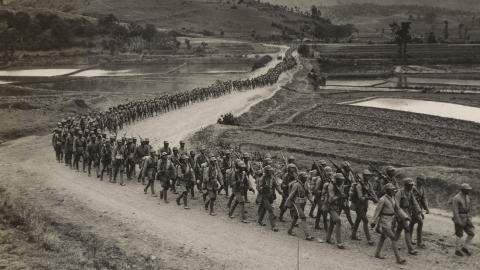Occupation and POWs
The Japanese started selecting prisoners and every day one was taken out and killed and eaten by the soldiers.
Indian POW, New Guinea
During the Second World War, Japan invaded and occupied vast swathes of territory in Southeast Asia and the Pacific. In some countries, the invaders established puppet governments. In China, invaded in 1937 but never fully conquered, the Japanese recruited Wang Ching Wei – a deserter from Chiang Kai-Shek's army – to head the Nanking Government. Wang's collaborationists had no real power. Treated with disdain by the Japanese, they were basically a tool to impose social control and curb the power of local warlords. In Burma, occupied from 1942, the Japanese capitalised upon anti-imperialist sentiment among the local population, granting nominal independence in 1943 and establishing a puppet government under Ba Maw. The Japanese also used captured Indian troops to form a National Indian Army commanded by Subhas Chandra Bose, which fought alongside the Japanese in the cause of Indian independence from Britain.
Other occupied territories were controlled by military governments and subject to martial law. Hong Kong was ruled by a military government under General Rensuke Isogai which controlled every area of political and public life. The Pacific island of Guam was also ruled directly by an army which ruthlessly imposed Japanese cultural practices upon the population. The Chamorros were forced to learn Japanese customs. Yen became the currency. People suspected of hiding friends or family members wanted by the authorities were harassed, beaten, tortured and executed.
These regimes were all characterised by a brutality that had become ingrained in the Japanese Imperial Army. The occupation of Hong Kong began with the bayoneting of wounded Allied soldiers in St. Stephen's Hospital; it continued in the same bloody manner. Roughly 10,000 women were raped in the month following Japanese victory. The occupiers recruited former members of the Hong Kong Police to orchestrate public executions. In Indonesia, occupied in 1942, civilians were arbitrarily arrested, tortured and sexually abused. Thousands were interned in concentration camps or used as slave labour for Japanese military projects.
Prisoners of War taken by the Japanese originated from many different countries: China, India, Burma, Britain and the Commonwealth, the USA, the Netherlands and the Philippines. Japanese military culture did not subscribe to the idea of surrender; becoming a POW was to disgrace oneself and one's country. Prisoners taken by the Japanese were brutally treated; the 1927 Geneva Convention was flagrantly ignored. The Red Cross was denied access to camps; beatings, executions, medical experiments, poor sanitation, starvation rations, disease and torture were part of everyday life. Prisoners such as Philip Meninsky visually chronicled their experiences using human hair, plant juice, blood and toilet rolls. Their work was later used as evidence at the Tokyo War Crimes Tribunal.
The Bataan Death March is one of the most infamous example of Japanese brutality towards POWs. Following the fall of Bataan in the Philippines, 75,000 American and Filipino prisoners were marched from the Bataan peninsula to prison camps; they suffered physical abuse, murder, torture and starvation. The construction of the Burma-Thailand Railway, a horrific slave labour project which killed around 90,000 Asian labourers and 16,000 Allied POWs (mainly through overwork, malnutrition and disease) is another. According to the figures of the Tokyo Tribunal, 27.1% of all western prisoners taken by the Japanese died; the Chinese figure is much higher. While just over 80,000 Western Allied POWS were released after the Japanese surrender, the Chinese figure was just 56. The Tribunal condemned the Japanese Prime Minister Tojo and six others to death for their responsibility for these crimes; sixteen more were sentenced to life imprisonment.
Did you know?
When the Japanese Army marched into Indonesia in 1942, they were initially greeted by the population with flags, enthusiasm and chants of Japan is our brother; they were seen as liberators from Dutch oppression
















